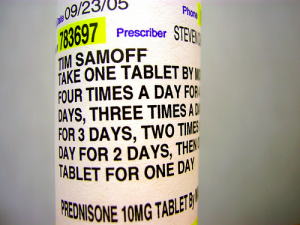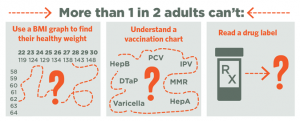Health Literacy and Digital Divide
“The degree to which individuals have the capacity to obtain, process and understand basic health information and services needed to make appropriate health decisions (Healthy People 2010)
Health Literacy
Health literacy is estimated to cost $106 – $236 billion annually and incorporates a range of abilities:
- To read
- Comprehend
- Analyze information
- Decode instructions, symbols, charts, and diagrams
- Weigh risks and benefits
- Make decisions and take actions


What is the digital divide?
The advent of the digital age during the previous decades posed a major challenge for public health in addressing the inequalities that occur with technological access between those who have computers and the Internet to those who do not. This might be followed quickly with the social access of the digital divide of those who have the resources and skills to use technologies and those who do not.
How does it affect communication?
Although not without controversy, the task of ensuring communication for health services so as to avoid further lack of access among individuals is largely a technical one. Recognizing the communication tools and the information available on the technological devices is key. Clients without computers cannot access information about health concerns, search for health care providers, and progress to see a doctor online.
Do you think digital inclusion is a social justice issue?
Taken together, this thought of digital divide gives new impetus to digital inclusion to pursue social justice with so much potential to protect the lives of those that are marginalized. The digital age causes an imbalance in accessing knowledge for those who do not have technology devices.
What is digital equity?
Typically, the response to digital inequity is not having the same resources and goes deeper than simply accessing technology. Moreover, how individuals are able to access the technology and use the features of that technology. For example, education plays a particular part in the use of the Internet activities as opposed to someone who does not acquire the skills to use the Internet for a broader range. Students therefore without technological devices, cannot receive the same education as those who have devices.
What are the barriers to people being online and the solution to those barriers?
Barriers exist significantly due to the low social economic status of individuals and families who cannot afford the technological product and the monthly fees to have Internet services. Solutions remain within our public library systems to progressing look at expanding services to include more computers for public use and research for students. Community centers can play role in providing linkages to online capability for their population.
What is NCLAS?

A Class About NCLAS (15:32) is an introduction to the National Culturally and Linguistically Appropriate Services (CLAS) Standards. This video was created by the Utah Department of Health, Office of Health Disparities.
Answer the following questions based on your viewing on the video.
- What are some communication methods that would work well with your community population?
- What images or phrases do you suggest to communicate?
- What communication channels would work well with your community?